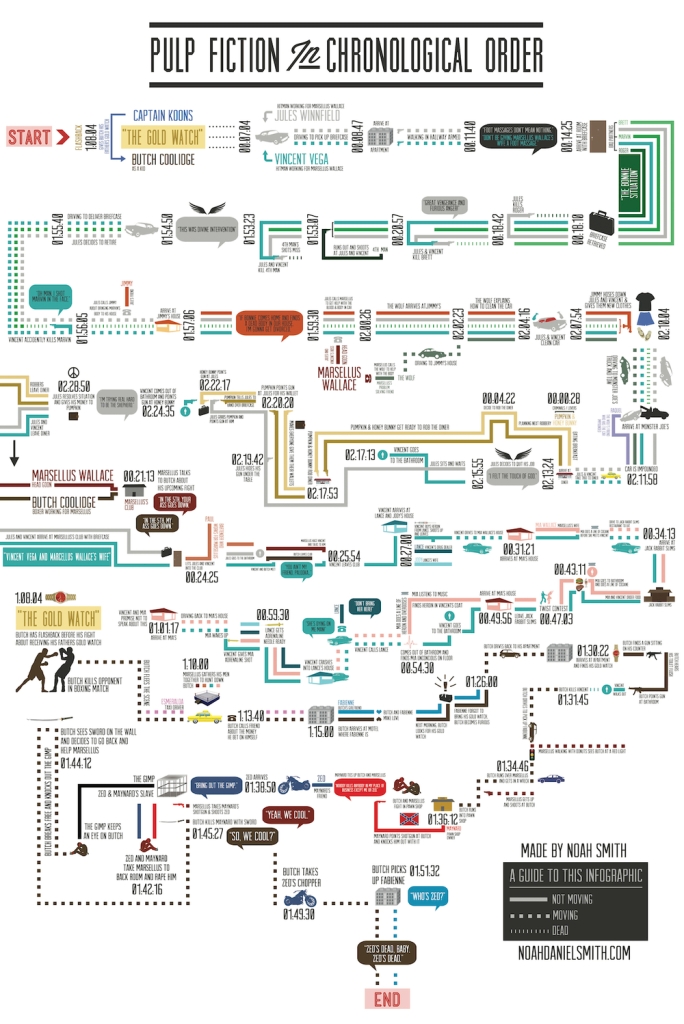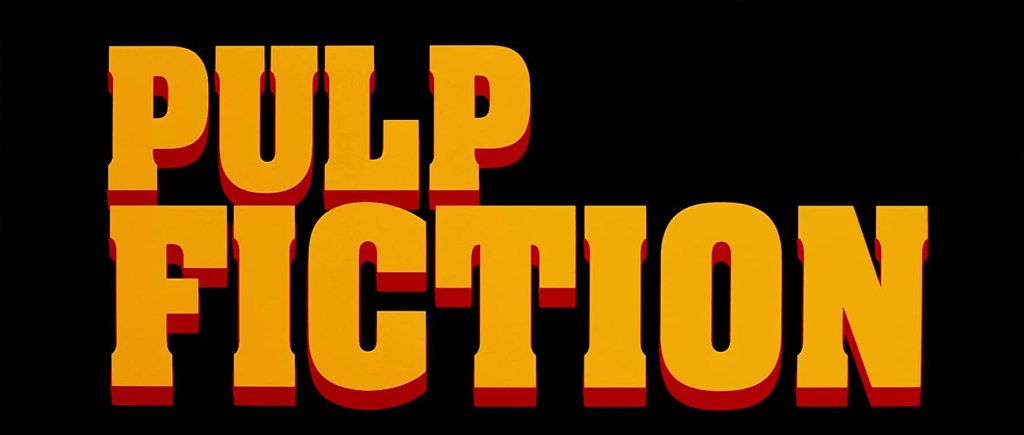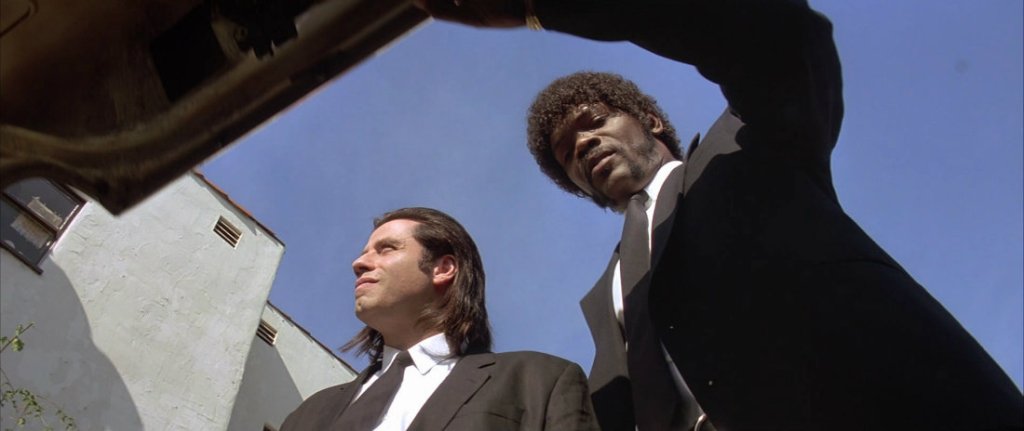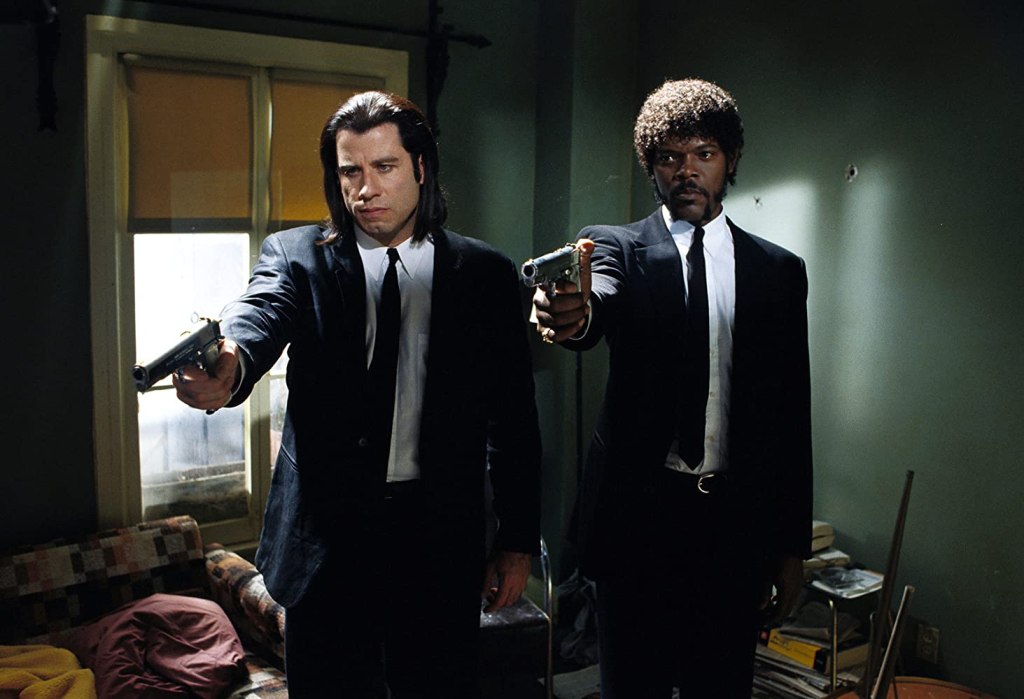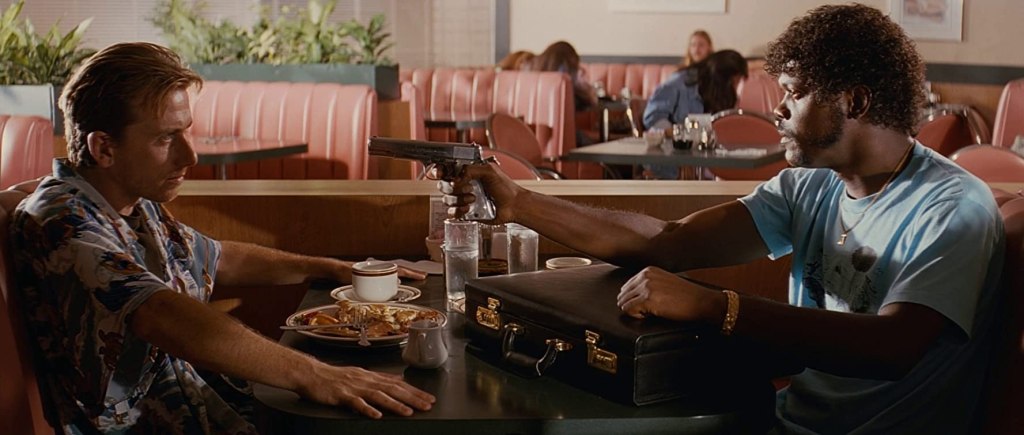“Experimental film is often the result of an auteur challenging established conventions with fresh ideas.” With reference to your chosen film option, how far do you agree with this statement?
Plan
Intro – Define auteur, who is Bazin and what does he say, introduce QT and PF
1st Paragraph – Dialogue heavy
2nd paragraph – over the top violence
3rd paragraph – mise-en-scene
Conclusion – easily identifiable
Essay
An auteur describes a director that has such a dramatic influence on the style of their film that it could be immediately identified as a film that director had worked on without any prior knowledge of the credits of the film. André Bazin, a film critic and philosopher working largely in the mid-1950’s opposed the expressive aspects of cinema such as German expressionism and Soviet montage, believing it to remove the realism from the scene, but was of the opinion that a film should be influenced by the creative mindset of the director. Bazin’s belief played a vital part in the development of the auteur theory after the publishing of an issue of his magazine ‘Cahiers du cinéma’ in 1954 which was hugely influential for French cinema and would later become a talking point for the rest of the world. Quentin Tarantino is an American director, quintessential of the idea of an auteur, expressed throughout all his films such as Pulp Fiction (1994) and his earliest film ‘Reservoir Dogs’ (1992), where his unique and captivating style of filmmaking gives his films a fresh and exciting appearance that engages the audience.
One of the most recognisable auteur-like features that Tarantino utilises within his films is the extended and heavy dialogue between characters, often occurring in one set location. Typically, most modern film directors will naturally avoid having a long drawn out scene of dialogue as it is often boring and fails to propel the story forward in an entertaining manner as exposition is given in an unengaging and boring style that doesn’t make an audience express any emotions towards a character/s. In theory, using dialogue heavy scenes to relay information would be an unwise decision when writing based on a large majority of examples that make a film uninteresting but Tarantino’s auteur style of filmmaking aids the dialogue choices he makes in creating an interesting scene and character/s. Many examples are present within Pulp Fiction but the prime example for how Tarantino’s auteur style is used effectively to create unconventional and yet intriguing dialogue can be found in the second scene, located in a car driving along a motorway before moving into an apartment building as Jules and Vincent head towards their target, a group of young associates of their boss, Marcellus Wallace, who isn’t happy with how they tried to double-cross him. The main defining feature of Tarantino’s dialogue is that it often has a mundane quality to it whilst remaining relevant to the plot and the story of the narrative. As Jules and Vincent drive towards the apartment, there discussion revolves around cheeseburgers and how European countries use the metric system so there is no such thing as ‘quarter pounder with cheese’. The two characters can be first heard discussing a ‘hash bar’, a drug that is legal in Amsterdam which Jules expresses that he want to move there because they cant search you if you are in possession of it, giving the audience an immediate look into how the two men think regarding their unsavoury business but then Tarantino switches the dialogue on its head by talking about something trivial that any ordinary American would discuss having come back from Europe, humanising the two men, portraying them as less of ruthless killers and making them more relatable people, going against traditional ideas of writing killers in film and further enforcing Tarantino’s unconventional style having a positive effect on the outcome of the film.
Violence can often be the difference between deciphering whether a film has been directed by Tarantino with his over the top and exaggerated use of it becoming one of the staples of his auteur filmmaking style. Tarantino carries this aspect of his style throughout all his films, with examples such as in Django Unchained (2012) where excessive amounts of blood is used during the shootout between Django and the slavers whilst gory scenes involving a slave having his arm ripped off and another where they are being whipped is used to show the horrors of slavery for black people in the 19th century antebellum south. In Pulp Fiction, the same exaggerated violence can be seen when Vincent shoots Marvin in the face and when Butch saves Wallace from the rapist and he is gunned down with a shotgun. Violence is commonplace in crime genre films but never to the extent that Tarantino uses it, going against the idea that when it comes to the theme of violence, it must appear realistic, instead electing to utilise it to either entertain or to show or represent a specific idea, with the case being in Pulp Fiction that the violence is over the top to simultaneously entertain and show the violent and crime filled lives that the characters live in sunny LA.
According to Bazin, mise-en-scene within film shouldn’t be expressive, instead being realistic of the world that we live in. Tarantino doesn’t entirely conform to these ideals as an auteur with the mise-en-scene of his films often being manipulated in favour of visuals rather than realism. In the film ‘Kill Bill Vol.1’, the films climax depicts a fight between ‘The Bride’ and O-Ren outside in Japan with the two facing off as the snow starts to fall just as they begin to clash swords. Tarantino’s auteur style mise-en-scene is present in Pulp Fiction also, most noticeably during the chapter “Vincent Vega and Marcellus Wallace’s Wife” when focusing on the 50’s style diner ‘Jack Rabbit Slim’s’. The interior of the restaurant is filled with, light up signs bearing the names of famous brands, pedestal seating, large dance floor, posters, old vintage cars and waiters dressed in the outfits of famous icons from years past such as Marilyn Monroe. Whilst the mise-en-scene isn’t revolutionary by any means, it varies very differently from crime genre films coming out at the same time and presents his authorship in how he wants to construct the look of the film. It could be that Tarantino was influenced by surrealist films that he watched growing up such as ‘Attack of the 50 Foot Woman’ which can be seen depicted on the wall of the restaurant.
There are very few filmmakers that can be considered auteurs but those that can are easily identifiable. Tarantino is the epitome of the word ‘auteur’ as he repeatedly goes against the conventions and ideals that other filmmakers are so keen to follow and his use of specific features such as exaggerated violence has made him easily recognisable and an iconic filmmaker. These along with other features he makes use of such as his episodic storytelling, continual use of actors that he trusts and wide varying camera angles such as his use of Dutch angles that make his films so appealing to an audience.
Re-draft Essay
An auteur describes someone working within the film industry such as a cinematographer or director that has such a dramatic influence on the style of the films they work on that when viewed, it could be immediately identified as a film that person had worked on without any prior knowledge of the credits of the film. Quentin Tarantino is an American director, quintessential of the idea of an auteur, expressed throughout all his films such as Pulp Fiction (1994) and his earliest film ‘Reservoir Dogs’ (1992), where his unique and captivating style of filmmaking gives his films a fresh and exciting appearance that engages the audience. This auteur theory spoken of was devised by André Bazin, a film critic working in the mid-1950’s who opposed the expressive aspects of cinema such as German expressionism and Soviet montage, believing it to remove the realism from the scene, but was of the opinion that a film should be influenced by the creative mindset of the director, something which Tarantino demonstrates an abundance of.
One of the most recognisable auteur-like features that Tarantino utilises within his films is the extended and heavy dialogue between characters, often occurring in one set location. Typically, most modern film directors will naturally avoid having a long drawn out scene of dialogue as it is often boring and fails to propel the story forward in an entertaining manner as exposition is given in an unengaging and boring style that doesn’t make an audience express any emotions towards a character/s. In theory, using dialogue heavy scenes to relay information would be an unwise decision when writing based on a large majority of examples that make a film uninteresting but Tarantino’s auteur style of filmmaking aids the dialogue choices he makes in creating an interesting scene and character/s. Many examples are present within Pulp Fiction with the prime example for how Tarantino’s auteur style is used effectively to create unconventional and yet intriguing dialogue can be found in the second scene, located in a car driving along a motorway before moving into an apartment building as Jules and Vincent head towards their target, a group of young associates of their boss, Marcellus Wallace, who isn’t pleased with how they tried to double-cross him. The main defining feature of Tarantino’s dialogue is that it often has a mundane quality to it whilst remaining relevant to the plot and the story of the narrative. As Jules and Vincent drive towards the apartment, there discussion revolves around cheeseburgers and how European countries use the metric system so there is no such thing as ‘quarter pounder with cheese’. The two characters can be first heard discussing a ‘hash bar’, a drug that is legal in Amsterdam which Jules expresses that he want to move there because they cant search you if you are in possession of it, giving the audience an immediate look into how the two men think regarding their unsavoury business but then Tarantino switches the dialogue on its head by talking about something trivial that any ordinary American would discuss having come back from Europe, humanising the two men, portraying them as less of ruthless killers and making them more relatable people, going against traditional ideas of writing killers in film and further enforcing Tarantino’s unconventional style having a positive effect on the outcome of the film.
Violence can often be the difference between deciphering whether a film has been directed by Tarantino, with his over the top and exaggerated use of it becoming one of the staples of his auteur filmmaking style. Tarantino carries this aspect of his style throughout all his films, with examples such as in Django Unchained (2012) where excessive amounts of blood is used during the shootout between Django and the slavers whilst gory scenes involving a slave having his arm ripped off and another where they are being whipped is used to show the horrors of slavery for black people in the 19th century antebellum south. In Pulp Fiction, the same exaggerated violence can be seen when Vincent shoots Marvin in the face and when Butch saves Wallace from the rapist and he is gunned down with a shotgun. Violence is commonplace in crime genre films but never to the extent that Tarantino uses it, going against the idea that when it comes to the theme of violence, it must appear realistic, instead electing to utilise it to either entertain or to show or represent a specific idea, with the case being in Pulp Fiction that the violence is over the top to simultaneously entertain and show the violent and crime filled lives that the characters live in LA.
According to Bazin, mise-en-scene within film shouldn’t be expressive, instead being realistic of the world that we live in. Tarantino doesn’t entirely conform to these ideals as an auteur with the mise-en-scene of his films often being manipulated in favour of visuals rather than realism. In the film ‘Kill Bill Vol.1’, the films climax depicts a fight between ‘The Bride’ and O-Ren outside in Japan with the two facing off as the snow starts to fall just as they begin to clash swords. Tarantino’s auteur style mise-en-scene is present in Pulp Fiction also, most noticeably during the chapter “Vincent Vega and Marcellus Wallace’s Wife” when focusing on the 50’s style diner ‘Jack Rabbit Slim’s’. The interior of the restaurant is filled with, light up signs bearing the names of famous brands, pedestal seating, large dance floor, posters, old vintage cars and waiters dressed in the outfits of famous icons from years past such as Marilyn Monroe. Whilst the mise-en-scene isn’t revolutionary by any means, it varies very differently from crime genre films coming out at the same time and presents his authorship in how he wants to construct the look of the film. It could be that Tarantino was influenced by surrealist films that he watched growing up such as ‘Attack of the 50 Foot Woman’ which can be seen depicted on the wall of the restaurant.
There are very few people that can be considered auteurs but those that can are easily identifiable. Tarantino is the epitome of the word ‘auteur’ as he repeatedly goes against the conventions and ideals followed by most while his use of specific features such as exaggerated violence has made him easily recognisable. These along with other features he makes use of such as his episodic storytelling in which he divides his films into chapters to establish structure, continual use of actors that he trusts with stars such as Samuel L.Jackson and Leonardo Di Caprio becoming familiar faces on his set as they each bring their own unique traits to their characters and a wide variety of camera angles such as his use of Dutch angles that make his films so artistically and entertaining to an audience as everyone expects a violent and tense film when watching Tarantino.
Essay Re-draft
An auteur can be defined as a filmmaker that has such a dramatic influence on the style of a film that it can be immediately associated with that specific person without any prior knowledge. This person is most commonly the director but can also include actors, cinematographers and others working within a film that add their own unique style to it.
André Bazin was a film critic and philosopher working mainly in the mid-1950’s at a time in which the French New Wave pushed the boundaries of cinema and was vital in the development of this auteur theory. He opposed expressive aspects of cinema, believing it to remove the realism from a scene and was of the opinion that a film should be influenced by the creative mindset of the director and this belief helped push the auteur theory which was hugely influential for French cinema after its publishing in the magazine ‘Cahiers du cinema’ in 1954.
Quentin Tarantino is an American director that is quintessential to the idea of an auteur director, expressed through his unique and captivating style of filmmaking which provides a fresh and exciting viewing experience for an audience. This style of filmmaking is present throughout his work such as Reservoir Dogs (1992) and Kill Bill: Volume 1 (2003) but his arguably most well regarded film is Pulp Fiction (1994).
One of the most auteur-like features utilised by Tarantino within his films is extended dialogue between characters, often occurring in one set location. Typically, modern film directors will avoid long drawn out conversations as its often boring and fails to propel the story forward in an entertaining way for the viewer as exposition is given in an unengaging manner that doesn’t promote feelings of emotion from an audience towards a character or event. Tarantino’s auteur style of filmmaking is used effectively to create unconventional and yet intriguing dialogue that allows for an audience to engage with the characters on screen. One example includes a scene in which Jules and Vincent are in a car driving along a motorway towards their target, a group of young men working for their boss. The main defining feature of Tarantino’s dialogue is that it often has a mundane quality to it whilst still remaining relevant to the plot and the films narrative. As the pair drive, the discussion revolves around topics such as cheeseburgers and how European countries use the metric system. The two characters also discuss a ‘hash bar’, a drug legal in Amsterdam causing Jules to express interest in moving there, giving the audience an intimate look into how the two men think, presenting them in one light as gangsters and juxtaposing this by making them appear as almost normal American citizens. Tarantino manipulates the dialogue from being something mundane and trivial, humanising the two men in comparison to their gangster profession, going against traditional ideas of writing gangster characters in film and further reinforcing Tarantino’s unconventional style to make an engaging film for the audience.
Perhaps the most noticeable trait in Tarantino’s films however is his graphic use of over the top, exaggerated violence that has become a staple of his auteur style. In Pulp Fiction, this exaggerated violence can be seen during the scene in which Vincent shoots Marvin after recovering him and a suitcase from their bosses ex-associates and is also present when Butch saves Wallace from a rapist who is gunned down with a shotgun. Violence is commonplace in crime genre films due to their nature of murders and gore but Tarantino goes against the idea that when it comes to violence it must appear to be a realistic representation, going against Bazin’s ideas and instead electing to use violence as a method of entertainment for an audience or to show a specific idea, with the case being in Pulp Fiction that violence is exaggerated to both entertain and show the violent lives that the characters lead as gangsters in LA.
According to Bazin, mise-en-scene within a film shouldn’t be expressive, instead remaining realistic to the world we live in without manipulation. Tarantino doesn’t conform to these ideals as an auteur as he often manipulates the mise-en-scene as he favours visuals over realism. The most notable example of this style is when Vincent takes his Mia Wallace out for dinner, driving to to a 1950’s style ‘Jack Rabbit Slim’s’ diner. The interior of the restaurant contains light up signs bearing the names of famous brands, pedestal seating, a large dance floor, posters, old vintage cars and waiters dressed in the outfits of famous icons such as Marilyn Monroe. The mise-en-scene isn’t revolutionary in terms of its style but it varies very differently from typical crime genre films coming out at the same time and presents his autership in how he constructs his films as out of the ordinary to immerse the audience in the characters’ world.
Tarantino is also known for his repeated use of specific actors that he trusts. Prominent actors in Pulp Fiction such as Harvey Keitel and Samuel L. Jackson are also in films such as Reservoir Dogs (1992) and Django Unchained (2012). Other directors do use actors they are familiar with but Tarantino uses a recognisable group of actors continually in his films with Samuel L. Jackson appearing in 6 of his films.
There are few filmmakers that can be considered auteurs but those that can are easily identifiable. Tarantino is the epitome of being an auteur as he repeatedly goes against the conventions and ideals established by filmmakers with his use of violence, dialogue and mise-en-scene making his films instantly recognisable. The implementation of auteur-like features is extensive in his filmmaking, with further examples of his style including his episodic storytelling present in Pulp Fiction and other films such as The Hateful Eight and his varying use of camera angles such as his use of Dutch angles which all contribute to a unique and entertaining viewing experience for an audience.
